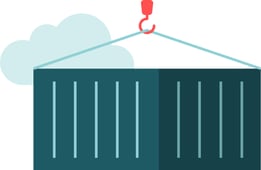
A new form of software containerization - serverless containers - is about to offer businesses a more secure, easier and faster-to-deploy method of deploying software across the organisation. It gives you all the benefits that containers have now, but without the need for in-depth expertise in setting up the environment. Let's take a look at what serverless containers can do for your technical team.
Serverless containers: a tl;dr for your colleagues
If cloud computing is part of your IT strategy, it’s likely you already use containers. By bundling each application into a single object that also encapsulates its configuration files, system libraries, and dependencies, it answers an old problem: a move to a new environment causing the app to fall flat on its face. Every app has to be set up in a certain way – and containerization brings that setup along for the ride, wherever the app is hosted.
So far, so great. But there are a couple of issues with the container approach. Whether you host your container on a small server or a big server, it’s still on a server – and if demand for your applications peaks and troughs over the day (and whose doesn’t?) that server may not be able to handle the bursts. Hence another model: serverless.
Serverless computing is a key offer of cloud providers like Tilaa. By separating the customer’s IT infrastructure – your applications and data – from the humming, buzzing mass of servers hosting it, you get (in effect) infinite server capacity, enabling almost the whole datacentre capacity to go to work for you if your web store (say) suddenly receives 15m frenzied customers instead of the usual 100. You don’t know which specific hardware your app’s running on – and you don’t care. All you do care about is that your apps are running smoothly and securely at a European-based datacentre like Tilaa’s.
That’s why containers and serverless are both in our playbook. Both carry strong advantages, both bring benefits to your business. But they’re not the same advantages. They’re complementary.
So why not combine them?
Serverless containers: finding the why
By removing the need to host containers on specific hardware, with all the limits that this implies, serverless containers combine the easy portability of containerization with the burst capacity of a serverless architecture – bringing your business the best of both. This new model is on the up and up, and many in the cloud computing space see it as the future.
With serverless containers, you can spend your day doing what is important - building and supporting the applications your business uses - and forget about the underlying infrastructure.
The problems and challenges it solves
The Big Benefit: serverless containers let you focus on providing service to your users, not frantically rejigging configuration files and switching code libraries when you need more capacity or change your hosting plan. You can concentrate on your business’s technology backbone – the mix of applications that form your competitive advantage – without worrying about the server infrastructure at the datacentre, any more than you care about how the tomatoes got to your supermarket when you go shopping.
No more small-problems-eating-huge-resources. With serverless alone, your application can fall victim to a stack of unintended consequences: a database trying to open more connections than your application can handle, a vast queue of requests building up in a few seconds of downtime because there’s no limit on them, and the retries that flood in afterward to make matters even worse. When you add containers to a serverless setup, you can control these flows and stop them becoming floods.
Unlimited scalability. From containers on a single server, to containers on a server space not allied to a specific blade in a rack: the advantage is obvious. All the capacity you need, when you need it – with the main advantages of containers like load-balanced redundancy and automatic scaling working together to deliver the performance needed.
And competitive cost! In a pure container play, most MSPs will charge you for all your containers, all the time – even the ones that aren’t in use, because the server capacity they need has to be always-on and always-up. In a serverless containerized world, a container is only called when it’s needed. So, you can have as many as you want, while only paying for the containers you actually use – with the stack of redundant containers growing and shrinking depending as you need them.
Conclusion
With all these benefits, it is obvious that serverless containers are a desirable choice for the development and deployment of contemporary applications. You can streamline operating procedures, reduce costs, and gain access to a scalable and effective infrastructure by adopting this technology. It is crucial to consider while creating your next application because cloud computing will depend on it in the future.
Tilaa: Your Effortless Cloud
At Tilaa we are convinced that the cloud was created to make everything easier. That's why we're currently developing our new Serverless Containers service .
With Tilaa's Serverless Containers, you effortlessly deploy and orchestrate container-based solutions without the burden of continuous maintenance. Experience the ease and efficiency of our cloud solution. Join us on this transformative journey and unlock the power of simplicity.

 '
'